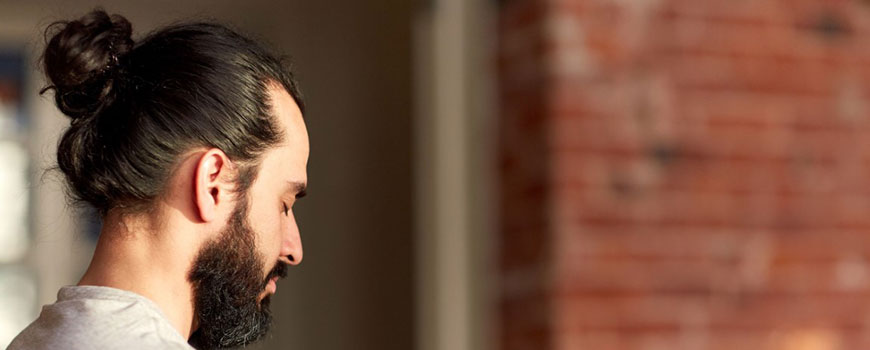What Is Traction Alopecia & Can It Be Reversed
When most of us think of the typical person suffering from severe balding, our mind usually imagines a greying, old man losing their hair thanks to genetics and age. Medically known as androgenetic alopecia, this may be the most common form of balding, affecting 80 million people in the U.S., but it’s far from the only way we lose our hair.
Traction alopecia occurs when hair has been pulled too tightly against the scalp. It’s also one of the few forms of hair loss attributed to mechanical causes, and not genetics, hormones, or other disease processes. Traction alopecia is commonly reported in women of African descent, though it has nothing to do with ethnicity or hair type. Instead, it’s the specific hair styles and techniques popular in these communities that ultimately cause traction alopecia. However, just because it’s more common in women, doesn’t mean that it doesn’t occur in men. With the recent surge in popularity of the “Man bun”, you may be putting your locks at risk.
As frustrating as any form of hair loss may be, the bright side of traction alopecia is that sufferers don’t have to fight against genetics. If caught early, traction alopecia is an easy form of hair loss to treat and prevent by simply changing your hairstyle.
What is Traction Alopecia?
Traction alopecia is essentially hair loss caused by hair regularly and aggressively pulling at the hair. As the hair follicles/bulbs/scalp is increasingly irritated, sufferers will feel stinging, pain, and tenderness. Small red bumps (folliculitis) may also appear. If these initial symptoms are ignored, permanent hair loss can occur. Early on, traction alopecia can be reversed. However, if trauma continues and irritation persists, scarring of the damaged hair follicle can occur. Once scarred, the hair stops growing entirely and cannot be reversed without invasive medical intervention.
What Causes Traction Alopecia?
Traction alopecia is almost always caused by hair styles that pull hair too tight against the fragile skin of the scalp. Though often associated with braids, weaves, and dreadlocks, traction alopecia also occurs with ponytails, buns, pigtails, extremely long hair, extensions, etc. Helmets and turbans are also known culprits.
What Are Symptoms of Traction Alopecia?
Telltale signs that you may have traction alopecia include:
- Scalp tenderness
- Red bumps on or near the scalp
- Broken hairs near the hairline
- Thinning or patchy areas of missing hair near the hairline
- Relief in scalp when tight bun released.
- Itching
If you notice these symptoms as soon as they appear, the damage can be reversed. However, waiting longer increases the chance of developing more severe, or even permanent hair loss.
Once scarring, or scarring alopecia occurs, treatment becomes significantly more difficult. Medical intervention by a dermatologist or hair restoration expert is strongly recommended as soon as symptoms occur.
How Can I Treat Traction Alopecia?
When caught early enough, traction alopecia can be completely treated and reversed without a doctor. If no scarring has occurred and there is no significant pain or swelling, simply letting your hair down and avoiding any hairstyles that causes scalp tension should resolve the issue.
However, be patient. The hair and scalp will need time to regrow. It can take several months, or even a full year to see progress. During this time, don’t be tempted to wear your hair tight at any time and be as gentle as possible to your hair and scalp.
If your traction alopecia has advanced to the point of significant balding, pain, swelling, or scarring—or you don’t see any new growth after a year of wearing your hair loose—it’s definitely time to see a dermatologist or hair restoration specialist.
First, your specialist will likely test your hair to ensure the cause of your hair loss is in fact traction alopecia. This may include a biopsy of your scalp; a minor outpatient procedure where a small sample of your scalp is submitted to the lab for microscopic examination.
Then once officially diagnosed, typical treatments include:
- Topical hair growth creams like minoxidil (Rogaine)
- Biotin or other natural hair growth supplements
- Oral or topical medications to reduce inflammation to the scalp
If scarring has occurred, no pills or creams will bring your hair back. The only way to reverse permanent hair loss is through a hair transplant procedure. Though this is an invasive surgery, it does have a high success rate for bringing your hair back to its former glory.
How Can I Prevent Traction Alopecia?
Traction alopecia is extremely preventable. Prevention doesn’t have to mean forever giving up the hairstyles that you love—though you might have to take regular breaks. Use proper hair styling techniques and strategies to minimize damage. Above all, avoid constantly pulling your hair too tightly into any style.
Maintaining your hair should never hurt. If you notice regular pain, stinging, or tension along your hairline, it’s time to try a different style. Braids or dreads, are better when they’re thick. Thin braids and dreads tend to pull more at the scalp. If you love the man bun but it’s giving you tension headaches, let it down and set your locks free.
Also, choose high-quality hair care products and minimize the use of chemicals. If you’re good to your hair and scalp, your hair and scalp will be good to you in return.
Want to learn more about treating or preventing traction alopecia? Trust the hair treatment experts at Limmer HTC. Our team is dedicated to providing our patients with incredible results so you regain the full head of hair you deserve. Contact us at 210-496-9992 or request an appointment online anytime.





